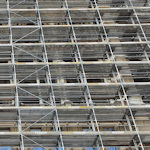
If you were approaching your 140th birthday, you’d need a face lift too. It just takes a little longer when you’re Vienna’s famous Rathaus (city hall).
- Renovation should finish by the end of 2024
- 10+ years process almost at its end
- Façade is already done (so great for photos)
- Book a historical walking tour* of the city
- See also:
Restored splendour
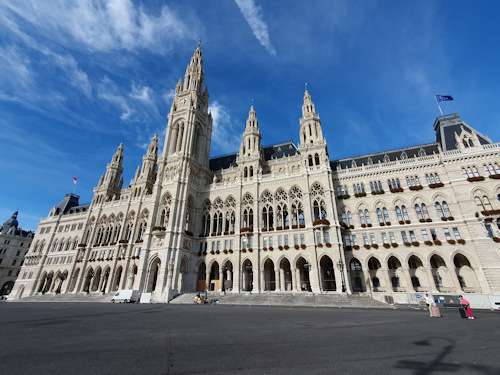
(The façade in all its restored pristine glory)
The restoration and renovation work on the Rathaus and its façade began in 2012 and should finish by the end of 2024.
If that sounds like a long time, consider that the façade alone covers around 40,000m2 of historical surfaces and sculpted designs.
That number is equivalent to about 95 basketball courts, if basketball courts were covered in reliefs and statues acting as metaphors and allegories for 3-pointers, rebounds, and tactical awareness.
(Pity the poor window cleaners, too, since the building has 2035 windows).
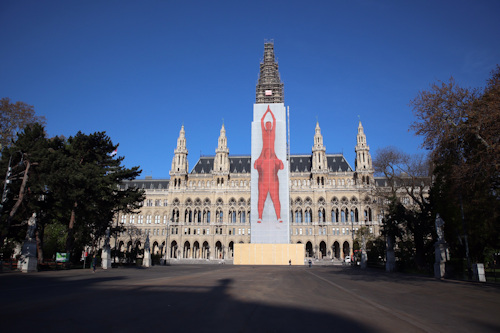
(They used the scaffolding around the main tower for art installations; photo © Stadt Wien PID/Bernato)
We’re now almost at the very end of the process. The entire façade, for example, has already emerged with a fresh gleam to it.
Just to give you an example of the work involved, think about the 17 carved figures that grace the exterior of the huge central tower.
Obviously, the statues needed more than a quick blast with the leaf blower. We’re talking about valuable artefacts of the 19th century construction boom that saw such prestige projects as the Rathaus emerge from the remains of Vienna’s city fortifications.
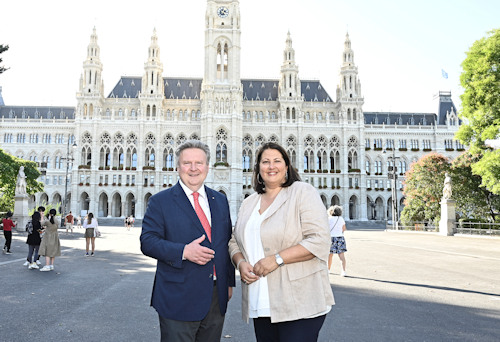
(Michael Ludwig (Vienna’s Mayor) and Kathrin Gaál (Deputy Mayor and City Councilwoman for Housing) enjoying the formal completion of the renovations on the façade in autumn 2023; press photo © C.Jobst/PID)
Built from Savonnières limestone, each figure is almost 3m high and weighs up to 1.8 tonnes. They provide both a decorative and representative role. So, for example, you have:
- Vindobona (the Roman name for Vienna) as the central figure at the front of the main tower, accompanied by two standard bearers (one for Vienna, one for the monarchy). The sculptor – Josef Fritsch – also created statues for the Burgtheater opposite the Rathaus
- Twelve figures carrying heraldic crests representing various crown lands belonging to Austria-Hungary (the name of the empire at the time of construction)
- Two figures serving as allegories for strength and justice. Like Fritsch, sculptor Franz Gastell also contributed to other monumental buildings of the time. For example, he did two of the figures you can see on the parapet of Austria’s parliament building
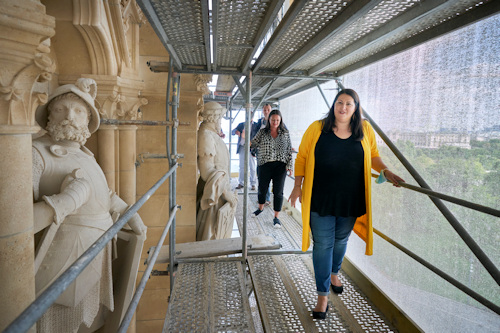
Kathrin Gaál reviews the work on the tower figures; press photo © PID/Markus Wache)
Another challenge that tested the skills of the restorers were valuable reliefs located at the mezzanine level of the tower. These depict three particularly important Habsburg rulers:
- Rudolf I: the first Habsburg to head up the Holy Roman Empire and also the first Habsburg to include Vienna in his dominions
- Franz Joseph: Emperor at the time the building went up, which explains why he gets a relief (you don’t bite the hand that feeds you). Though, to be fair, Franz Joseph was always one of the most important personalities in Habsburg history, as this article explains
- Rudolf IV: another influential Habsburg chap. He founded the University of Vienna, for example, in the 14th century

(The final touches to a mammoth project: renovation of the outside steps)
Fortunately for visitors, all that remains of this mammoth renovation project now is work on the perron: the exterior steps leading up to the main entrance.
Tip: if you wish to see inside the Rathaus, the city offers free tours (in German but with an English audioguide available). Or drop into the GAME CITY event (also free).